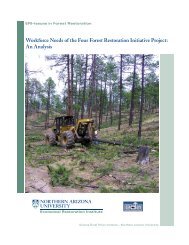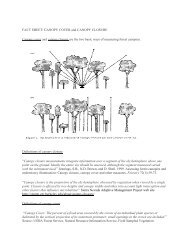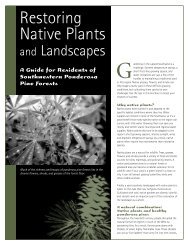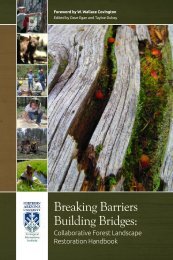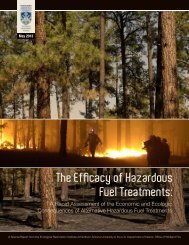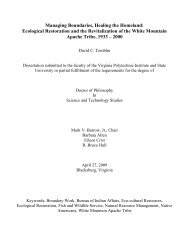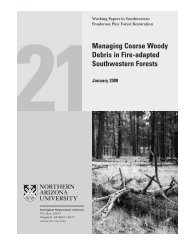Did Tallgrass Prairie Extend into Pennsylvania? - ERI Library ...
Did Tallgrass Prairie Extend into Pennsylvania? - ERI Library ...
Did Tallgrass Prairie Extend into Pennsylvania? - ERI Library ...
Create successful ePaper yourself
Turn your PDF publications into a flip-book with our unique Google optimized e-Paper software.
Laughlin: <strong>Prairie</strong>s in <strong>Pennsylvania</strong> 15Figure 1. Locations of three prairie-types in <strong>Pennsylvania</strong>. Light gray areas arePhysiographic Provinces, drawn from Fenneman (1928), that contain a prairie-type.Stars represent the "blazing star prairies" in the unglaciated region of theAppalachian Plateau (Aaron 1974), circles represent the xeric limestone prairies inthe Ridge and Valley (Laughlin and Uhl 2003), and triangles represent theserpentine barrens on the Piedmont (Reed 1986, Tyndall and Hull 1999).codominant and Schizachyrium scoparium is also common on a few sites.Anemone virginiana , Solidago nemoralis, Monarda fistulosa, Lithospermumcanescens, Asclepias tuberosa, A. verticillata, A. viridiflora, Penstemon hirsutus,and Packera obovata are some of the most frequently found forbs on these sites(Laughlin and Uhl 2003) . Eleven species found on these prairies are listed in<strong>Pennsylvania</strong> as endangered, threatened, or of special concern. These species arethe following: An emone cylindrica, Bromus kalmii, Unum sulcatum,Lithospermum canescens, Onosmodium molle var. hispidissimum, Ophioglossumengelmannii, Dichanthelium oligosanthes, Ranunculus jascicularis, Ruelliahumilis, Cassia marilandica, and Oligoneuron rigidum , The limestone prairies arerestricted to south-southwest facing slopes within the valleys of the Ridge andValley and are found on shallow, rocky, and slightly alkaline limestone-derived,clay loam soils (Laughlin and Uhl 2003).



